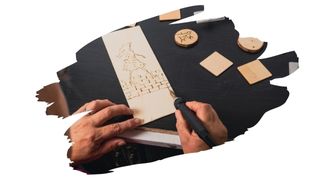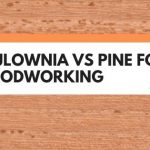Paulownia is in incredibly lightweight lumber that is so buoyant, it’s even used for making surfboards. In fact, the soft pliable grain of this hardwood makes it fantastic for making model aircrafts.
Yet, how well does it hold up as an option for wood burning artwork?
Well, in this post, you will learn which four things you need to check for when selecting wood for pyrography. You will also learn why Paulownia wood can be more than a little tricky to burn into.

This post may contain affiliate links to products that we receive a commission for (at no additional cost to you). Learn more here.
What Kind Of Wood Is The Best Kind For Pyrography?
The best kind of wood is easy to burn and provides a clean canvas for your work.
So, ideal pyrography timbers tend to fit the following four criteria;
1). Light Color Grain
Very light grained woods are perfect because you can see all the intricacies of your artwork clearly. But dark grained wood types can mute the shading and definition of your drawings.
Related Post: Is Basswood A Good Wood For Pyrography?
2). Uniform Grain
Skip over wood types that have fairly straight uniform grain.
Wood types that have deep contrasting grain, such as Red Oak, can make your images look like a faded photocopy.
Related Post: Beginners Guide To Reducing Oak Grain Contrast (Explained)
3). Little To No Tree Resins (Or Any Other Oils)
You need a clean canvas, one that is free of any tree sap/pitch, or previous oil finishes/stains.
These resinous substances will bubble over under the heat of your pyrography pen. And this will only end up making your burn lines appear less sharp.
4). No Toxins, Chemicals, or Poisonous Compounds
This should go without saying, but many people tend to skip over this bit.
But, essentially, avoid burning any type of wood that is saturated with tree sap (such as Cedar or Pine). And never ever burn into lumber sourced from poisonous trees.
So, this means wood types such as the Yew tree, should not be used for pyrography.
However, on top of that, manufactured woods such as Plywood and MDF, should be crossed off the list too. Why? Well, because they are saturated with formaldehyde-based glues.
Related Post: Is Plywood Really A Safe Wood For Pyrography?
Got It! So Where Does That Put Paulownia? Can You Wood Burn On Paulownia Wood?
Well, first off, you can burn Paulownia wood safely as it is not poisonous. But, burning into this wood is about as tricky as trying to work with Balsa.
You see, Paulownia is one of the lightest woods around. It is incredibly soft (just like Balsa wood).
And, along with Balsa, it is one of the three lightest hardwoods (with Cuipo wood rounding out that short list).
Now, on one hand, this makes Paulownia great for model aircraft and the like. But, it’s softness — while a boon for model makers — is a big problem for pyrography enthusiasts.
You see, because this wood is so soft, its fibers easily crush under very light impact. You need to have an incredibly light touch with your pen, because you’re likely to end up gouging out this timber.
In short, Paulownia is a very delicate lumber, which means that you need to be painstakingly careful as you burn onto it.
This means that, at best, this wood is OK for practice but not for any long-lasting artwork. Especially as Paulownia wood can become marked and scratched very easily.
To Wrap Up, Here Are The 3 Key Takeaways From This Post…
- 1). The best types of wood for pyrography have light color uniform grain.
- 2). Paulownia wood is one of the top three lightest hardwoods. The other two are Balsa and Cuipo.
- 3). Paulownia wood is very soft, and dents easily. This makes Paulownia difficult to burn onto.
Reference:
Ab Latib, H., Choon Liat, L., Ratnasingam, J., Law, E. L., Abdul Azim, A. A., Mariapan, M., and Natkuncaran, J. (2020). “Suitability of paulownia wood from Malaysia for furniture application,” BioRes. 15(3), 4727-4737.



